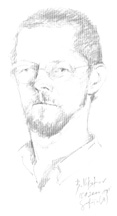Global Haiku and the Work of Jim Kacian
Richard Gilbert

|
|
What is the vision of global haiku, or of a
global haiku movement? Can a global haiku community be created? |
|
|
|
Jim Kacian

|
Haiku is undoubtedly the most popular contemporary poetic genre, worldwide, considering the number of countries and languages in which haiku are composed, and the number of poems published per year. This fact, combined with advances in information technology, has brought about the possibility of creating an international literary community founded on common aesthetic and formal intentions—based upon the powerful ground of haiku, which has demonstrated a remarkable ability to transmit itself from Japanese soil in essential ways, overleaping language, cultural, and historical differences. In this sense, haiku seem powerfully resonant with the spirit of our time.[1]
Yet, it has been argued recently, that literature itself is fundamentally a regional art form, best nurtured on local ground, by local organizations. The situation provoking this statement by Dimitar Anakiev, a Balkan haijin and publisher of repute, represents a conundrum resulting from the phenomenon of the global haiku. In English, the “the” found in the phrase “the global haiku” implies a unity, or a unitary literature. As this phrase becomes more frequently and loosely applied, with its implicit conception of a single international literature, Anakiev's comment begs the issue: should the concept of “global haiku” be resisted, or even spurned? This question is particularly relevant for haiku organizations now forming or remaking themselves with the intention of promoting haiku as a global art form.
What is the vision of global haiku, or of a global haiku movement? Can a global haiku community be created? Does haiku, as a global literary genre, provide a common ground for internationalism and international literary community, or is the term “global haiku” a kind of oxymoron? As a theoretical or academic matter, these points may be moot, as the future is impossible to predict; however, innovation is taking place on the ground. Particularly, I would like to mention the work and activities of Jim Kacian, an American haijin, editor and publisher, who recently presented a keynote speech: “Around the World as Briefly as Possible,” at the “Haiku Without Borders” Pacific Rim Haiku Conference, in Long Beach, California, November, 2002. The speech (forthcoming, in publication) was in part the result of a unique haiku pilgrimage, “a trip around the world in the name of haiku” begun at the millennium, involving international haiku conferences, workshops, television broadcasts, and the inauguration of regional and international organizations (quotations are from Kacian's speech).
steamy nightThe haiku below provides a representative example of Kacian's innovative style and international impact:
fireflies
out in the rain
the riverwhich first appeared in Kacian's book, Six Directions (1996), followed in 1997 by the First Mainichi Anthology of Prize-Winning Haiku.[2] To date, the above haiku has been translated into Bulgarian, Dutch, French, German, Irish, Japanese, Romanian, Turkish, Serbian (et cetera), appearing in various national and international publications. In 1997, Kacian became the editor of Frogpond: Journal of the Haiku Society of America, an office he continues to hold. As founder and owner of Red Moon Press, the largest publishing house dedicated solely to haiku and related forms in English, worldwide, he has published The Red Moon Anthologies of English-Language Haiku, whose volumes are influential in the English haiku movement, due to their high standards of selection and presentations of developing trends.[3]
the river makes
of the moon
clouds seenFrom New Zealand, Kacian traveled on to Tasmania and then Sydney, introducing haiku and guest-teaching. Reflecting on this experience, he recollects a discussion with students at a Sydney preparatory school, concerning “the power that writing is, the power of carving out a space in the mind which is wholly our own, unassailable. We talk about how much in our lives is dictated by others—by our culture, our parents, our teachers, our friends. Writing, we decide, is a place where we are not beholden to all these influences, but only to ourselves. Writing is a room of one's own, and all the [students] agree, they would be eager to spend time in such a place.”
through clouds
seen through
|
top
|